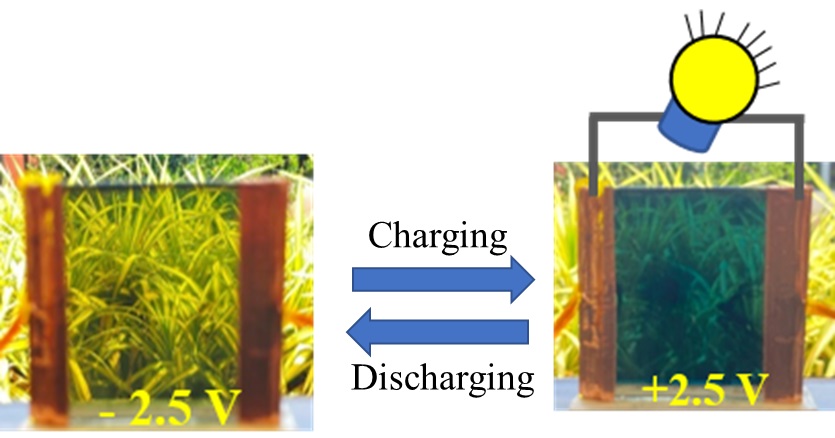Researchers at the Centre for Nano and Soft Matter Sciences (CeNS) and the Jawaharlal Nehru Centre for Advanced Scientific Research (JNCASR) have fabricated a smart window that provides a low-cost alternative to the traditional smart windows used in buildings and cars. The researchers’ device incorporates a chemically synthesized conducting polymer as an electrochromic layer, coated over a low-cost transparent conducting electrode.

A graphical depiction of how the dual-functional, polymer, electrochromic smart window works. Courtesy of S.C. Karumuthil et al., J. Mater. Chem. A, 2022, 10, 23265-23273, DOI: 10.1039/d2ta05973h.
Smart windows have the potential to increase energy efficiency in modern structures. However, their high processing and material costs, especially for traditional, indium tin oxide (ITO)-based smart windows, have limited the use of this technology.
According to team scientist Mukhesh K. Ganesha, the use of hybrid, transparent conducting electrodes enabled the team to reduce the amount of tin-doped ITO needed for device fabrication, without compromising the electrochromic performance of the device. By using hybrid electrodes, the team reduced the required thickness of the ITO from 280 to 60 nm.
The electrochromic device has an areal capacitance of about 8 mF (i.e., millifarad) cm−2. Its capacity for energy storage supports its dual-functionality capabilities.
Further, the device can be made to switch from a transparent state to a dark state and vice versa by applying a nominal amount of voltage. When the device is in a dark state, it is also in a charge state, and its energy storage can be used to power, for example, a time display or a small electronic gadget.
When the device is switched from a dark state to a transparent state while it is discharging in order to power a small electronic gadget, it demonstrates dual functionality. The researchers said that the device can be used to power small electronics on a daily basis with the energy that is stored in the dark state.
“We have optimized different characteristics of the conducting polymer including the thickness, concentration, and solvent processability of conducting polymer (poly(o-methoxyaniline)) to fabricate high-performance, dual-functional electrochromic devices,” said team scientist Subash Karumuthil.
The electrochromic device exhibited an optical contrast of 57% between colored and transparent states. It demonstrated a rapid switching ability, with a response time of about 5 s, and it showed good stability over more than 500 cycles.
The scientists have set up a semi-automated production plant for the production of the hybrid, transparent conducting electrodes for use in smart window applications. The team is making additional smart window prototypes using its hybrid TCE, with the goal of proving their capability with other materials. The transparent conducting electrodes can be made available to interested industries and R&D labs by request if they wish to explore collaborative projects.
The research was published in the Journal of Materials Chemistry A (www.doi.org/10.1039/D2TA05973H).